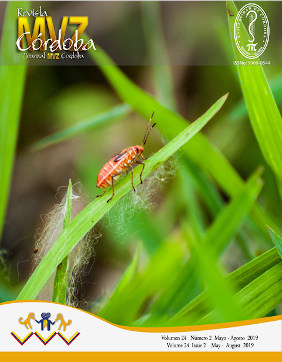Canine atypical hyperadrenocorticism associated with hypothyroidism
Hiperadrenocorticismo atípico e hipotiroidismo canino
Show authors biography
Hyperadrenocorticism (HAC) is one of the most common endocrinopathies in dogs, caused by excessive synthesis of cortisol. Atypical or occult HAC is a syndrome characterized by the presentation of clinical, biochemical, and imaging alterations compatible with hypercortisolism, but normal results in endocrine tests that are conventionally used for HAC diagnosis. However, these patients present high serum concentrations of precursors or other corticoadrenal hormones. The present study describes the case of an 8 years old female canine, Bichón Frisé, epileptic and treated with phenobarbital, presenting clinical signs associated with HAC, in which the low-dose dexamethasone suppression test and stimulation with ACTH resulted within normal values. The measurement of adrenal steroids, after ACTH stimulation, showed abnormal elevation of estrogen and progesterone, the latter persisting after the patient was spayed. Treatment with trilostane allowed the reduction of progesterone levels and the partial resolution of clinical signs. However, full clinical recovery was only achieved after the diagnosis and treatment of concomitant hypothyroidism. The challenge that represent the diagnosis of atypical HAC highlights the importance of performing and having availability of panels that include measurement of adrenal steroid hormones other than cortisol, as well as considering the occurrence of other concomitant endocrine metabolic diseases.
Article visits 5406 | PDF visits
Downloads
- Pöppl A, Coelho I, Da Silveira C, Moresco M, De Carvalho G. Frequency of endocrinopathies and characteristics of affected dogs and cats in southern Brazil (2004-2014). Acta Sci Vet. 2016; 44(1379):1-9. https://doi.org/10.22456/1679-9216.81099
- Castillo V, Pessina PP, Gardía JD, Gallelli MF, Miceli DD, Cabrera MF. Ectopic ACTH syndrome in a dog with mesenteric neuroendocrine tumour: a case report. Vet Med. 2014 59(7):352-358. https://doi.org/10.17221/7623-VETMED
- Kooistra HS, Galac S. Recent advances in the diagnosis of Cushing’s syndrome in dogs. Topics in Compan An Med. 2012; 40(2):259-267. https://doi.org/10.1016/j.cvsm.2009.10.002
- Behrend EN, Kooistra HS, Nelson R, Reusch CE, Scott-Moncrieff JC. Diagnosis of spontaneous canine hyperadrenocorticism: 2012 ACVIM Consensus statement (small animal). J Vet Intern Med. 2013; 27(6):1292-1304. https://doi.org/10.1111/jvim.12192
- Behrend EN. Canine hyperadrenocorticism. En: Feldman EC, Nelson RW, Reusch C, Scott-Moncrieff JC, Behrend EN. Editores. Canine & Feline Endocrinology, 4a ed.. St Louis: Saunders Elsevier; 2015. https://doi.org/10.1016/B978-1-4557-4456-5.00010-9
- Behrend EN, Kennis R. Atypical Cushing’s syndrome in dogs: Arguments for and against. Vet Clin Small An. 2010; 40(2):285-296. https://doi.org/10.1016/j.cvsm.2009.11.002
- Hoffrogge S, Fels L, Schmicke M, Mischke R. Atypisches Cushing-Syndrom bei einem Hund. Tierarztl Prax Ausg K. 2017; 45(3):186-192. https://doi.org/10.15654/TPK-160255
- Fowler KM, Frank LA, Morandi F, Whittemore JC. Extended low dose dexamethasone suppression test for diagnosis of atypical Cushing’s syndrome in dogs. Domest Anim Endocrinol. 2017; 60:25-30. https://doi.org/10.1016/j.domaniend.2017.03.002
- Sieber-Ruckstuhl NS, Boretti FS, Wenger M, Maser-Gluth C, Reusch CE. Evaluation of cortisol precursors for the diagnosis of pituitary-dependent hypercortisolism in dogs. Vet Rec. 2008; 162(21): 673-678. https://doi.org/10.1136/vr.162.21.673
- Ristic JME, Ramsey IK, Heath FM, Evans HJ, Herrtage ME. The use of 17-Hydroxyprogesterone in the diagnosis of canine hyperadrenocorticism. J Vet Intern Med. 2002; 16(4): 433-439. https://doi.org/10.1111/j.1939-1676.2002.tb01261.x
- Behrend EN, Kemppainen RJ, Boozer AL, Whitley EM, Smith AN, Busch KA. Serum 17-alpha-hydroxyprogesterone and corticosterone concentrations in dogs with nonadrenal neoplasia and dogs with suspected hyperadrenocorticism. J Am Vet Med Assoc. 2005; 227(11):1762-1767. https://doi.org/10.2460/javma.2005.227.1762
- Syme HM, Scott-Moncrieff JC, Treadwell NG, Thompson MF, Snyder PW, White MR, Oliver JW. Hyperadrenocorticism associated with excessive sex hormone production by an adrenocortical tumor in two dogs. J Am Vet Med Assoc. 2001; 219(12):1725-1728. https://doi.org/10.2460/javma.2001.219.1725
- Monroe WE, Panciera DL, Zimmerman KL. Concentrations of noncortisol adrenal steroids in response to ACTH in dogs with adrenal-dependent hyperadrenocorticism, pituitary-dependent hyperadrenocorticism, and nonadrenal illness. J Vet Intern Med. 2012; 26(4):945-952. https://doi.org/10.1111/j.1939-1676.2012.00959.x
- Miller AG, Dow S, Long L, Olver CS. Antiphospholipid Antibodies in Dogs with Immune Mediated Hemolytic Anemia, Spontaneous Thrombosis, and Hyperadrenocorticism. J Vet Intern Med. 2012; 26(3): 614-623. https://doi.org/10.1111/j.1939-1676.2012.00922.x
- Feldman EC. Evaluation of twice-daily lower-dose trilostane treatment administered orally in dogs with naturally occurring hyperadrenocorticism. J Am Vet Med Assoc. 2011; 238(11):1441-1451. https://doi.org/10.2460/javma.238.11.1441
























